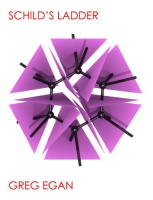Much like Hugh Howey, Greg Egan is an author that I approach with caution. They are both capable of great writing, but they also have their limitations.

ISBN: 978-1597805445
Greg Egan, 2013-07-29
English
A book that is less than the sum of its parts. Scientists create monster, scientists argue over monster, scientists solve the monster problem with science magic. (2/5)
For Howey it's his inability to turn his amazing vignettes into longer stories, and for Egan it's his basing the story on a scientific concept or idea that, while intriguing, can't carry a novel and doesn't deserve the prominence he gives it.
Schild's Ladder is one of those.
It's supposed to be the hardest of Egan's hard SF, with "hardness" being a measure of how close to known science the story heaves. Egan, however, is someone who uses and abuses computer science on the regular, and once your characters are immortal omniscient demigods, the fact that the fictional universe doesn't allow faster than light travel becomes a fig leaf over what is essentially science fantasy.
The big idea in Schild's Ladder is that the universe at its lowest level is a graph[a], and it is explained completely by the fictional "Quantum Graph Theory" that is a true theory of everything[b], correctly describing how the universe works. This fictional theory, with its origin in the spin networks of quantum gravity, is at first glance reasonable. The story does make it off the starting line in good shape, and the first chapter or so ticks along nicely, albeit with some forgivable dashes of technobabble. Then, the first act ends with a catastrophe that is explained well from an in-universe perspective and leaves us with a rapidly expanding cosmic ball of death - a novo-vacuum - that devours anything it comes across.
Then, it's not just the universe that runs into a new kind of vacuum. The idea of Quantum Graph Theory is a good one, but any fictional theory would have done just as well.
The real version of QGT, Loop Quantum Gravity[c][1], is more complex - and the theory closest to QGT that I'm aware of is Stephen Wolfram's theories in A New Kind of Science which, to quote Cosma Shalizi, (...) must either conflict with special relativity (...), or conflict with quantum mechanics (...), or indeed both. It is a non-starter.
[*][e].
Since the QGT can't provide a proper framework for the in-universe plot, it becomes a combination of a deus ex machina and a Big Dumb Object that is whatever the author needs to advance the plot. Here the whole "hard SF" angle falls flat - all those diagrams, and all the expositions of QGT are ultimately just fantasy. It gives us throwaway lines like:
After a while, she spoke again. "Think of all the different dynamic laws that might make topological sense, in terms of the propagation of various kinds of particles that are defined as patterns embedded in a graph. I know that's horribly vague, but I don't think you'd want the version with added jargon."
(...)
"Now imagine each one is a quantum state vector in a big fat Hilbert space. All of them orthogonal to each other."
— Schild's Ladder, location 2531
It's not that these sentences don't mean anything. It's just that they don't matter. It's very advanced technobabble, but could have been any kind of technobabble. I imagine these words make sense to the author, but wouldn't the equivalent explanation "the novo-vacuum is a combination of all possible universes" be better, with the mathematical argument relegated to endnotes? As it is, it's just bad writing.
But then it gets worse - for the author, at least. The novo-vacuum is indescribable.
Sophus said, "Because what lies behind the border is not another vacuum, another set of rules. It has no classical properties like that to discover."
— Schild's Ladder, location 1785
But describe it Egan must, because you can't build your plot and your story around a reference point that can't even be described to your readers.
What follows, is, from what I can understand, what Egan thought to be the non-scientific aspect of the story. Schild's Ladder is named after the mathematical method of maintaining the same direction while traveling through a warped space where "the same direction" can mean many things[f][2], and Egan uses this as a metaphor for our personalities: how do we remain true to ourselves while still changing as we must in order to live? In the novel, the catastrophe that is set up in the first act prompts two diametrically opposite reactions that form two camps: one wants to destroy the ball of death, the other wants to learn from it. Obviously both can't have their way - but can we compromise without selling out, or is the only way forward unilateral action?
We never find out, because after having plodded along for a good number of pages, a second catastrophe pushes us into the final act - and we leave science behind for a trippy ending reminiscent of 2001: A Space Odyssey[g]. Here, Egan runs headlong into the problem outlined above: he must describe in an accessible way something that according to him is so alien as to be indescribable. Which he does, in a very 2001 kind of way. It's trippy, and it's passable - but it's fantasy, and almost completely decoupled from the previous expositions of QGT in the sense that besides a very insignificant exception you could have cut all the expositions and not missed anything.
The sum of this is a story that can be summed up as "scientists create monster, scientists argue over monster, scientists solve the monster problem with science magic".
This is the downfall of Schild's Ladder. It tries to make too much of a theory that isn't quite up to the task of being a plot framework, no matter how many science-ish expositions it's drenched in.